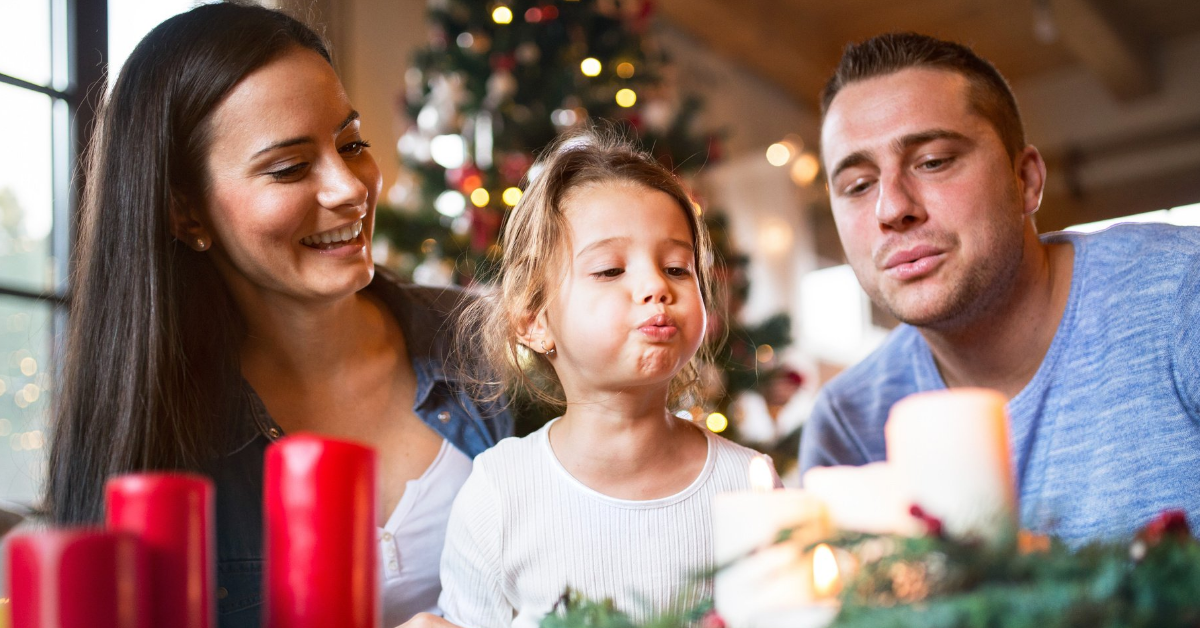By Stina Kielsmeier-Cook
As a lifelong Christian, Advent has always been one of my favorite times of the liturgical year. The candles, the hymns in a minor key (is there a better song than O Come, O Come Emmanuel?), the reflective readings on hope, peace, love and joy—these are things that mean so much to me. To add to the drama of the season, I gave birth twice during December, and the long, uncomfortable wait for my children to be born added a poignancy to the Advent themes of anticipating Jesus’ arrival.
Over the last decade, however, Advent has become a point of tension in my family. My husband stopped believing in God several years after we got married, and suddenly we had to face the holiday season as an unexpected interfaith couple. For the first few years after Josh’s deconversion, we used a family Advent guide that I downloaded from the internet, but it didn’t fit our family. Christian symbols and songs were often triggering for him. We soon agreed that reading apocalyptic scripture and singing archaic song lyrics wasn’t going to work in our joint family traditions. But how else could we participate in my beloved Advent rituals as a family when the traditional resources fell flat? And how could I still pass along the things I loved most about Advent to our kids?
Ever since, I have been on a quest for interfaith-friendly family resources for Advent and Christmas. While I have continued my own personal Advent readings, here are a few things that have worked for our Christian-agnostic family,
Interfaith Advent practices
- Focusing on Advent themes of faith, hope, peace, and love. Last year, the American Baptist Church that I attend with our kids on Sunday mornings sent home a kid-friendly Advent package so families could participate in this season despite COVID-19 restrictions. The package included Advent candles and activities we could do together via Zoom with our church community. We adapted the activities so that every Sunday of Advent we could do our own variation on the Advent themes. It went like this: each Sunday during Advent, we lit a candle after supper. Then, Josh and I each shared a concrete example related to that week’s theme of faith, hope, peace, or love—usually, a piece of art, poem, song, or a story. Sometimes I shared a Bible verse; Josh often read a poem. Our kids love our Sunday Advent evenings together. It’s a time of sharing from our hearts about what is most important. The Advent themes are ones that my husband and I can both embrace, no matter what our beliefs.
- Reading a non-religious text that ties to the themes of Advent. Our family loves the book All Creation Waits by Gayle King. It contains 25 daily reflections for Advent, but instead of focusing on the Biblical story, it describes how animals prepare for winter. At night, our family cozies together on the couch, and we take turns reading about how chickadees, turtles, and white-tailed deer are preparing during this season for the bitter cold months ahead. The themes tie well to the Advent season.
- Drawing on ancestral rituals. My great grandparents immigrated to the United States from Sweden, and I have inherited Scandinavian traditions that we now share as a family. The book The Yule Tomte and the Little Rabbits contains 25 short chapters, one for each day of Advent, and we read the story together. Santa Lucia day falls on December 13, and together we read about the tradition and bake our own Lucia buns. We also make doorknobs, which are peanut butter balls dipped in chocolate, which is something that my husband’s family always did together when he was a child. These traditions give our kids a connection to their ancestral heritage in ways that are not explicitly religious.
- Celebrating the shortest day of the year. As a Christian married to an agnostic, my traditions and rituals are fairly easy to come by. There are centuries of Christian texts, songs, and practices to draw from to celebrate the season. For my husband Josh, who comes from a Christian background, it’s harder to find ways to transmit his values to our kids during this time of year. One day that is important to Josh is the winter solstice on December 21. This day marks the least amount of daylight for us in North America and the slow transition back to more daylight. Most often, we celebrate the solstice by making a fire in the backyard and reading a childrens’ book called The Shortest Day. We talk about the seasons, the way the earth’s tilt towards the sun shapes our amount of daylight, and we wonder together at the evening stars.
Truth be told, it’s unlikely that my family will do all the things on this list this year. There is so much pressure around the holidays, and as the practicing Christian in my family, I feel extra weight of passing down my faith to our kids. When I worry about their faith formation, I remind myself that faith is always a gift and that I can trust God to be good in their lives. No matter how our Advent rituals go this year, I hope our kids know God’s love and hope by how their parents respect and honor each other’s beliefs in this season.
Your turn
Make public announcements in the congregation about some of the above resources or practices. Acknowledging that many of us are in interfaith families helps to normalize it.
About the author
Stina Kielsmeier-Cook is the author of the spiritual memoir Blessed are the Nones: Mixed Faith Marriage and My Search for Spiritual Community. She works as Director of Communications at the Collegeville Institute, where she is also the managing editor of Bearings Online. She lives in Minneapolis, MN with her husband Josh and two kids.



